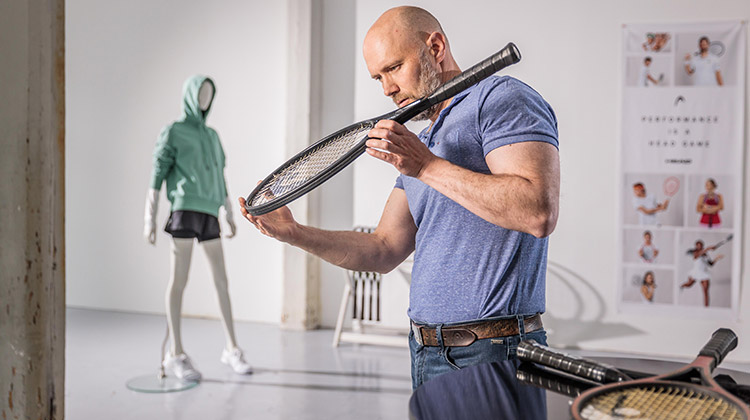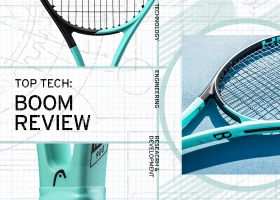How to choose a tennis racquet in 10 steps
Let’s be honest:
there is no such thing as “the perfect tennis racquet”.
However, there is certainly the best tennis racquet for every type of player. Believe it or not, there are many factors to be taken into consideration when it comes to choosing. Use this guide to find the tennis racket that best suits your game.
Navigation:
1. Choosing the right tennis racquet
1. CHOOSING THE RIGHT TENNIS RACQUET
Using the right racquet can make a huge difference, as it will help you to reach a higher level of tennis and to increase your overall performance on the court.
Before you choose the right one, it’s important to understand all the elements that compose a tennis racquet.
Racquets are a unique piece of equipment and some aspects are simply a matter of preference. However, there are also fundamental guidelines you can follow to ensure you have the best one for your playing level and style.
2. HEAD SIZE & HEAD SHAPE
The racquet head size measures the area where the strings create the face of the racquet. It falls into one of these 3 categories:
- Midsize - 85-97 in2 / 550-625 cm2
- Mid-plus - 98-105 in2 / 630-680 cm2
- Oversized - 106-135 in2 / 685-870 cm2
The head size impacts 2 aspects of your game:
- Power: when hitting the ball your racquet behaves like a trampoline and the larger the trampoline the higher the bounce effect.
A ball sinking into a larger head will receive a greater rebound effect from the strings resulting in more powerful shots. - Control: larger heads offer a larger hitting area and a bigger sweet spot.
They are therefore quite forgiving if the hit is not perfectly placed in the center of the racquet.
On the other hand, a larger head size feels harder to maneuver and delivers less control.
The greater trampoline effect comes at the loss of hit consistency and precision.
SUMMARY
- The bigger the head size the more power delivered by the trampoline effect
- The smaller the head size the more maneuverability and precision
- Small heads fit expert players, delivering their own power to the hit and seeking more consistency
- Larger heads appeal to beginner and intermediate players seeking more power and a larger sweet spot
3. RACQUET LENGTH
The length of a racquet is measured from the butt of the handle to the tip of the head.
It ranges between 27 inches (the most common) and 29 inches (the maximum length allowed in professional and non-professional tennis).


When evaluating length, it is important to understand the trade-off between reach and maneuverability. A longer racquet will provide a bigger reach allowing you to hit a ball further away from your body.
The downside is that longer racquets are generally harder to maneuver.
Therefore; shots close to the body, net volleys and other hits can be more difficult when playing with a longer frame.
SUMMARY
- A longer racquet results in more reach, more power and higher swing-weight
- A longer racquet will have less maneuverability
- The choice depends mainly on the player style rather than the player level. A strong server and baseline player will benefit from a longer frame more than a net player
4. RACQUET WEIGHT
The weight of a racquet is measured, without strings, in grams or in ounces.
A heavier racquet is more powerful, more stable and transmits less shock to the handler. Alternatively, a lighter racquet is easier to maneuver and will not exhaust the player’s upper body like a heavier one.
Keep in mind that there are ways to make a light racquet heavier (e.g. by adding lead tape) but it's almost impossible to reduce the weight of a racquet.
SUMMARY
- A heavier racquet will have more power and stability
- A lighter racquet allows for better physical endurance
- Heavier racquets are suited to baseline players with strong deep hits
5. BALANCE
The balance point of a racquet is defined as the point along the length of the racquet where the weight is split evenly between the head and the handle.
An evenly balanced racquet would have its balance point exactly in the middle of its length.
Balance is measured unstrung as the distance in mm between the butt cap and the balance point.
When talking about balance a racquet falls into one of these 3 categories:
- Headheavy – Center of gravity is shifted slightly towards the tip of the racquet - Balance > 350mm;
- Headlight – Center of gravity is shifted slightly towards the handle of the racquet - Balance < 330mm;
- Even –weight is evenly distributed - Balance between 330mm and 350mm.
A headheavy racquet is generally used by baseliners.
A headlighter racquet can be the better choice for a classic volley player.
6. SWINGWEIGHT
It is the dynamic measurement linked to the static measurements of weight and balance: it could be defined as the perception of weight given by the racquet when swung. It depends on the racquet size and weight and on the way the weight is distributed along with the racquet.
Swingweight is measured unstrung in kg * cm2 and it is normally expressed as a dimensionless value ranging from 270 to 310.
Generally speaking:
a head heavy racquet has a higher swing weight compared to a headlight racquet with the same weight.
A long racquet will have a higher swingweight when compared to a shorter racquet with the same weight.
The higher the swing weight, the heavier the racquet is going to feel.
It will be more fatiguing to handle but, at the same time, it will provide more power and stability and a higher acceleration to every hit.
SUMMARY
- High swing weight means more effort is required to handle the racquet
- High swing weight provides more acceleration to every hit
- As a general rule, you want to play with the heaviest racquet you can swing, that won’t fatigue you over the course of a long match
7. FRAME STIFFNESS
When evaluating stiffness consider that power, control and comfort are at stake.
At the same time, keep in mind that stiffness is perceived in a different way by every player and is also affected by the strings installed on the frame.
A flexible racquet or felxible frame provides more control and comfort but absorbs more power as it deforms more when hitting the ball.
Conversely, a stiff racquet doesn’t deflect as much on impact providing more power, but less control.
A stiffer frame is generally less comfortable as it transmits stronger shocks to the upper limbs.
Stiffness is measured with the RA method which analyzes how flexible a racquet is when a static force is applied in one point of the racquet, normally located in the shoulder area.
The RA index ranges from 55 to 75 falling in one of these subranges:
- 55-60 low stiffness
- 61-65 medium stiffness
- 66-70 rather stiff
- 71-75 very stiff
The RA index points out a static measurement at a certain point of the racquet., It does not describe the overall stiffness of the racquet.
There are many different kinds of dynamic components (e.g. bending stiffness, torsion stiffness, compression stiffness) which play a role on the overall perceived stiffness.
SUMMARY
- Perceived stiffness is determined by the frame of the racquet and the installed strings
- The RA value mainly indicates the stiffness in the shoulder area of a racquet
- The stiffer the racquet, the more power
- The softer the racquet, the more control, and comfort
- An advanced player, capable of providing power, might prefer the control and comfort of a softer racquet
- A stiffer racquet can help beginner/intermediate players provide more power
- Players with elbow/shoulder issues should look at softer racquets (≤ 66RA)
8. THE BEAM
The beam of a tennis racquet is the thickness of the racquet head. A thicker beam makes the racquet stiffer and sends more energy back into the ball at impact resulting in more power.
A thinner beam makes the frame more flexible and absorbs more energy creating a more precise feel, improving control, and improving comfort as less of the shock of contact is going to be transferred to the arm.


For a given thickness the cross-section of the beam can have 2 shapes: rectangular (box beam) or roundish (elliptical beam).
Generally speaking, a box beam with its edgy cross-section is stiffer bending-wise and torsion-wise than an elliptical, rounded cross-section.
SUMMARY
- A thicker beam means that the racquet can be stiffer
- A thicker beam delivers more power to the ball but is harder to control;
- A thinner more flexible beam is easier to control but delivers less power to the ball
- A rectangular beam is stiffer than an elliptical one.
9. GRIP SIZE
The tennis grip size is the measurement in inches of the perimeter of the handle's octagonal cross-section.
Typically, the grip size falls within the range 4in - and 4 ⅝ in and it is ranked from 0 to 1. according to the following table.
It is very important to play with the proper grip size as it makes a big difference in how your hits will perform.
The correct grip size is the one that, when holding an eastern forehand grip, allows you to exactly fit the index finger of your non-hitting hand in the space between your fingers and your palm.
SUMMARY
- The right grip size is crucial for the comfort and the handling of a racquet;
- If in-between two sizes choose the smaller one and eventually built up your grip size with an overgrip.
10. CPI CHART
All HEAD Tour racquets are reported in the Head CPI Chart (Control-Power Index).
The chart shows different values for each model of the respective racquet silos (families).
Each Tour-Racquet (not all previously released but all upcoming Tour racquets) also indicates this value on the racquet at the outer shaft.
The higher the value the more power the racquet has.



















